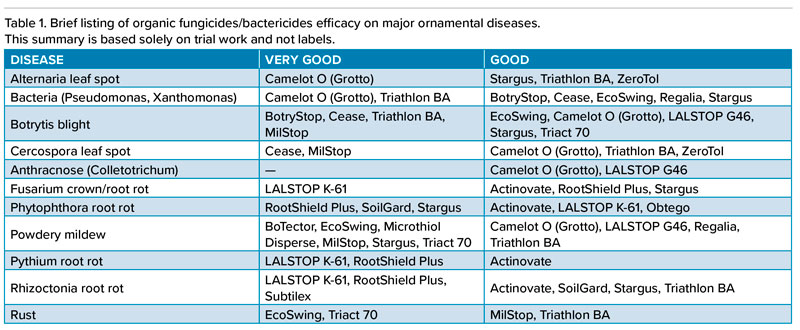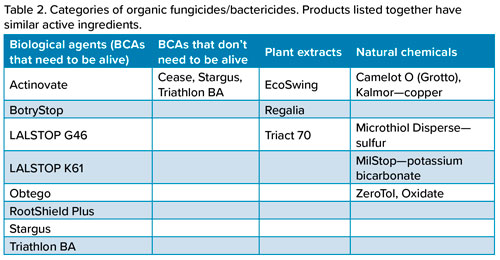1/1/2024
What Makes a Product OMRI-listed?
A.R. Chase
I’ve been thinking about what goes into making an organic product for disease control. Here’s a brief review of the history and organic products used for disease control.
History
In 1990, the Organic Foods Production Act was established and a new standard was being developed. The California Certified Organic Farmers (CCOF), in cooperation with Oregon Tilth Certified Organic (OTCO), the Organic Trade Association (OTA) and the Organic Crop Improvement Association (OCIA), evaluated inputs. These groups believed that a single resource specializing in input review and materials evaluation was critical in creating a uniform standard. Two of the first subscribers to OMRI were the Northeast Organic Farmers Association of New Jersey and the Florida Organic Growers.
What does OMRI mean? These are the initials for “Organic Materials Review Institute.”
OMRI began operation in June 1997 with financial backing from a wide range of organizations, including Newman’s Own Organics, Whole Foods Market, Smuckers Quality Beverages and the Humane Society of the United States. OMRI was founded to evaluate materials for use in organic agriculture. At that time, there were more than 40 separate certifiers who were performing organic certification using a wide variety of both state and private standards. It obviously meant that not all “organic" products were held to the same standards.
Many years later, OMRI launched the OMRI Canada program in 2013 to provide review of products for use under Canadian Organic Standards, and in 2020 launched the OMRI Mexico program, reviewing products under the Mexican Organic Products Law.
Reasons OMRI-listed products are selected
Some reasons companies and individuals might choose OMRI-listed products are:
■ It’s easier for their customers to find and trust products.
■ It allows farmers to determine whether a product should be used in organic production.
■ Input suppliers can market their products to organic producers with confidence.
■ Organic certifiers appreciate that OMRI-listed products have been checked for prohibited ingredients and the manufacturing process is allowed.
■ It's a faster approval process at EPA to approve products. Conventional products are held to a different standard and considerably longer timeline for review at EPA.
■ The length of time for a product to complete the review process under OMRI is about three months.
■ Often OMRI listing leads to shorter REI than conventional products, making them more user-friendly.
There are many assumptions about what “organic” means. Words that are sometimes used interchangeably include “biologicals” and “green products.” Many biologicals are OMRI-listed, but other products/ingredients that are okay include ZeroTol, certain coppers, sulfur and many essential oils. Natural products include sulfur, copper (like Camelot O), horticultural oil, Neem oil (Triact 70) and bicarbonates (like MilStop). Not all “natural” products are safe for ornamentals. They must be tested carefully on your crops under your conditions to make sure you don’t damage the crop.
Are “green” products held to the same efficacy standards as conventional products? There’s no efficacy standard for federal registration for any disease-control product that I’m aware of. EPA does require efficacy trials, but doesn’t review them or even ask for them to be supplied by the registrant. Some state agencies (like DPR in California) do require submission of efficacy trials before reviewing possible registration in that state.
Some features of biopesticides/organic products:
■ Generally shorter REI
■ Generally lower in residue appearance
■ Less likely for resistance development
■ Generally safer for workers
Some disadvantages of biopesticides:
■ Generally more expensive
■ Generally less effective
■ Generally harder to use/place in a program
What OMRI-listing means for efficacy
One important consideration is whether or not OMRI-listed products are as effective as conventional products. My experience based on trial reviews on all crops (not just ornamentals) is that they can be as effective.
Is there an OMRI-listed product for all diseases that’s as effective as conventional products? Nope. Sorry to break the bad news to you, but there are several diseases of ornamentals that really cannot be adequately controlled with organic products. These include: black spot (Diplocarpon), black root rot (Thielaviopsis), Cylindrocladium crown/root rot (there are some products for Cylindrocladium leaf spot), downy mildew, Sclerotinia blight and Southern blight (Sclerotium). So while some trials on some crops may show some effective control of one of these diseases, I don’t think you can rely on them. These diseases are hard to control with conventional products as well.
Table 1 shows a very brief overview of organic products for the most common diseases on ornamentals. I chose to show them in two columns—very good control and good control. If you have an outbreak, I would suggest starting with the very good products unless none are available.
Are OMRI-listed products safe for plants? What I mean here is can OMRI-listed fungicides cause phytotoxicity? Yes, some of the least safe are the oil-based products, especially the essential oils from herbs like rosemary. Additionally, peroxide type products are not safe on all crops, either. Always check products (conventional and OMRI-listed) for safety on your specific crops under your conditions.
Do OMRI-listed products last as long as conventional products? Can you alternate between organic and conventional fungicides? You can as long as you’re aware if the organic fungicide is a living biological or can tolerate the conventional product. Table 2 summarizes some of the categories of organic fungicides.
Conclusions
■ Do not take anything for granted and do your homework.
■ Figure out what disease you’re fighting/trying to prevent.
■ Check which organic products are best for that disease—if there are any.
■ Check the product safety before broadscale use.
■ Always practice IPM and prevention. It really is the key to successful ornamental production. GT
A.R. Chase is with Chase Agricultural Consulting.

